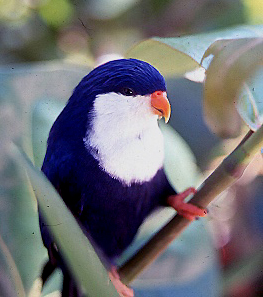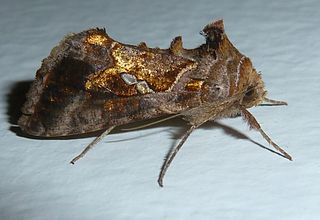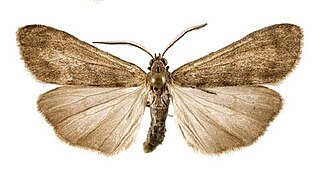
Boraginaceae, the borage or forget-me-notfamily, includes about 2,000 species of shrubs, trees, and herbs in 146 to 156 genera with a worldwide distribution.

The Noctuidae, commonly known as owlet moths, cutworms or armyworms, are a family of moths. They are considered the most controversial family in the superfamily Noctuoidea because many of the clades are constantly changing, along with the other families of the Noctuoidea. It was considered the largest family in Lepidoptera for a long time, but after regrouping Lymantriinae, Catocalinae and Calpinae within the family Erebidae, the latter holds this title now. Currently, Noctuidae is the second largest family in Noctuoidea, with about 1,089 genera and 11,772 species. This classification is still contingent, as more changes continue to appear between Noctuidae and Erebidae.

Clytie or Clytia is a water nymph, daughter of the Titans Oceanus and Tethys in Greek mythology. She is thus one of the 3,000 Oceanid nymphs, and sister to the 3,000 Potamoi.

Noctuoidea is the superfamily of noctuid or "owlet" moths, and has more than 70,000 described species, the largest number of any Lepidopteran superfamily. Its classification has not yet reached a satisfactory or stable state. Since the end of the 20th century, increasing availability of molecular phylogenetic data for this hugely successful radiation has led to several competing proposals for a taxonomic arrangement that correctly represents the relationships between the major lineages.

Heliotropium is a genus of flowering plants traditionally included in the family Boraginaceae s.l., but placed in the family Heliotropiaceae within the Boraginales order, by the Boraginales Working Group.. There are around 325 species in this almost cosmopolitan genus, which are commonly known as heliotropes. They are highly toxic to dogs and cats.

Heliotropium arborescens, the garden heliotrope or just heliotrope, is a species of flowering plant in the borage family Boraginaceae, native to Bolivia, Colombia, and Peru. Growing to 1.2 m (3.9 ft) tall and broad, it is a bushy, evergreen, short-lived shrub with dense clusters of bright purple flowers, notable for their intense, rather vanilla-like fragrance. Common names also include cherry pie and common heliotrope. Note that the common name "garden heliotrope" may also refer to valerian, which is not closely related.

The blue lorikeet is a small lorikeet from French Polynesia and the Cook Islands. It is also known as the Tahiti lorikeet, violet lorikeet, Tahitian lory, blue lory, nunbird, and the indigo lory. It was formerly found on 23 islands around Tahiti, but now restricted to perhaps eight islands: Aitutaki, Apataki, Arutua, Kaukura, Manuae, Maupihaa, Motu One, Rangiroa, and possibly Manihi and Manuae. Its plumage is mainly dark blue and it has a white area over its upper chest, throat and face. The first captive breeding in the UK was by the Marquess of Tavistock in the 1930s. He was awarded a silver medal by the Foreign Bird League for this achievement.

Heliotropium arboreum is a species of flowering plant in the borage family, Boraginaceae. It is native to tropical Asia including southern China, Madagascar, northern Australia, and most of the atolls and high islands of Micronesia and Polynesia. Common names include velvetleaf soldierbush, tree heliotrope, veloutier, and octopus bush. It is a shrub or small tree typical of littoral zones reaching a height of 3.6 m (12 ft), with a spread of about 5 m (16 ft).
Heliotropium aff. wagneri is an undescribed plant in the family Boraginaceae. It resembles Heliotropium wagneri, but differs in fruits breaking up into four nutlets and flowers that are always yellow, never white.
Heliotropium dentatum is a species of plant in the family Boraginaceae. It is endemic to Yemen. Its natural habitats are subtropical or tropical dry forests and subtropical or tropical dry shrubland.

Heliotropium amplexicaule is a species of heliotrope known by several common names, including clasping heliotrope, blue heliotrope, and summer heliotrope. It is native to South America, especially Argentina, but it is known on several other continents where it is an introduced species, and in some areas such as eastern Australia, a noxious weed.

Heliotropium curassavicum, commonly called salt heliotrope, a species of flowering plant in the borage family (Boraginaceae). It is native to much of the Americas, from Canada to Argentina, including the West Indies and Hawaii. It can be found as an introduced, and sometimes invasive, species in Africa, Asia, Australia, and Europe. It thrives in salty soils, such as beach sand, alkali flats, and salt marshes. It is often found in disturbed coastal sites.

Heliotropium europaeum is a species of heliotrope known by the common names European heliotrope and European turn-sole. It is native to Europe, Asia, and North Africa, but it is widely naturalized elsewhere, such as in Australia and North America. It grows as a roadside weed in some places. This is an annual herb growing from a taproot and reaching maximum heights near 40 centimeters. The stem and oval-shaped leaves are covered in soft hairs. The inflorescences are coiled spikes of white flowers with fuzzy or bristly sepals. Each flower is just a few millimeters wide. The fruit is a bumpy nutlet.

The tomato looper or golden twin-spot moth(Chrysodeixis chalcites) is a moth of the family Noctuidae, subfamily Plusiinae. It mainly lives in southern Europe, the Levant and tropical Africa, but can be seen migrating across much of Europe. In 2013, it was spotted in Canada. It is an important horticultural pest in New Zealand.

The Hawaiian tropical low shrublands are a tropical savanna ecoregion in the Hawaiian Islands.

Heliotropium indicum, commonly known as Indian heliotrope, Indian turnsole is an annual, hirsute plant that is a common weed in waste places and settled areas. It is native to Asia. It is widely used in native medicine in Tamil Nadu, India.

Heliotropium anomalum is a species of flowering shrub in the borage family, Boraginaceae, that is native to the Hawaiian Islands, Guam, Christmas Island, Saipan, Tinian, Wake Island and New Caledonia. Common names include Polynesian heliotrope, Pacific heliotrope, Scrub heliotrope and hinahina kū kahakai (Hawaiian). H. a. var. argenteum is the official flower of the island Kahoʻolawe in Hawaii.

Utetheisa connerorum is a moth of the family Erebidae. It is endemic to the Galapagos archipelago, where it is the most widespread of all Utetheisa species. It has been found on Baltra, Fernandina, Floreana, Genovesa, Isabela, Marchena, Pinta, San Cristóbal, Santa Cruz, Santa Fé, and Santiago.

Heliotropium crispum is a species of flowering plant in the family Boraginaceae, native to western Africa, Egypt, Sudan, south-western Asia, and Pakistan. It was first described by René Louiche Desfontaines.
















